This post may contain affiliate links. Read our disclosure policy.
Check out The Ultimate Guide to Chocolate Chip Cookies Part One, plus The Ultimate Guide to Chocolate Chip Cookies Part 2 and Ultimate Guide to Chocolate Chip Cookies Part 3!
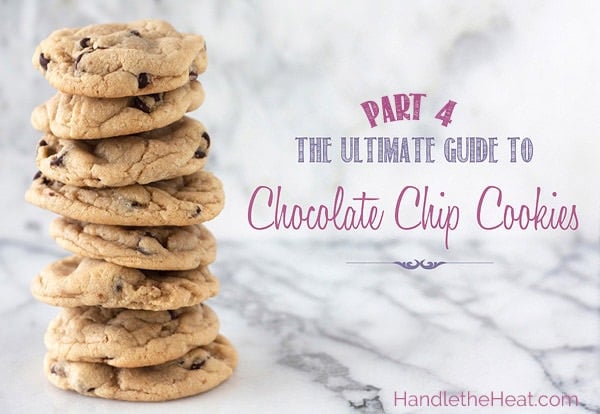
I’m doing a happy dance because today I’m sharing PART FOUR of my Ultimate Guide to Chocolate Chip Cookie series. I’ve received a lot of questions and comments about specific baking techniques and products and how they affect chocolate chip cookies. You guys wanted to know how oven temperature, creaming duration, baking surface, and baking pans affect cookies. Some people swear by certain techniques, while others unknowingly have problems with various products and methods. The below experimental batches will hopefully help you in troubleshooting why your cookies end up a certain way, whether that be flat, burned, underbaked, crisp, chewy, or whatever else!
I used an *adapted* version of the Nestle Tollhouse Chocolate Chip Cookie recipe as my control and made small variations among the baking methods and techniques to show you how they affect the cookie. I kept everything else the same in each recipe test so we could observe the differences in the finished cookie, photographing all the results for you. Together we’re on a journey to discover exactly how baking recipes work. See the comparison photos at the end of this post. Hopefully this will help you to discover why your cookies turn out the way they do and how to make YOUR version of the ultimate chocolate chip cookie!
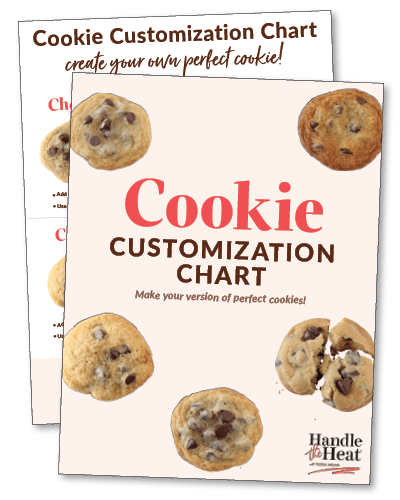
Free Cookie Customization Guide!
The science-based guide so you can bake perfect cookies every time!
Tools and Ingredients Used (when applicable):
–Spring-Loaded Cookie Scoop (Medium or 1 1/2-Tablespoon size)
–Chicago Metallic sheet pans
–Escali Digital Food Scale
–KitchenAid 5-quart Stand Mixer
–Oven thermometer
–Unbleached parchment paper
-Gold Medal All-Purpose Flour
-Fine sea salt
-Light brown sugar
-Large eggs
-Unsalted butter at a cool room temperature
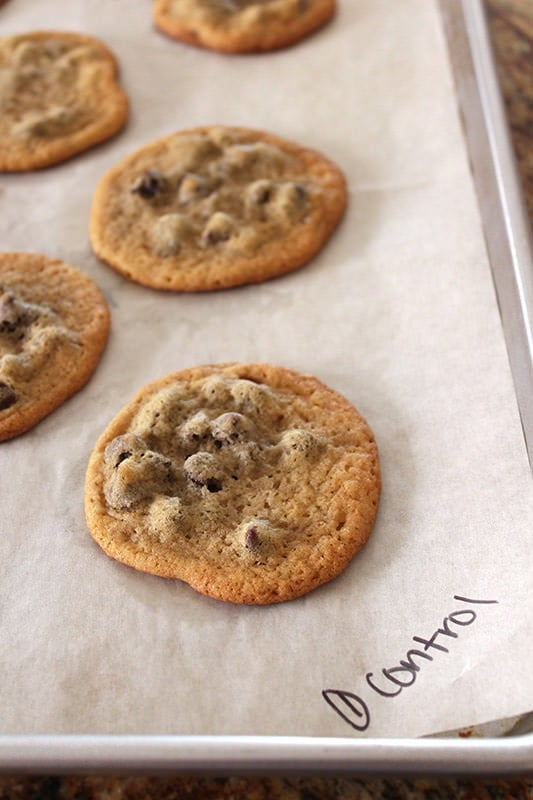
Ingredients:
1 cup plus 2 tablespoons (142 grams) all-purpose flour
1/2 teaspoon baking soda
1/2 teaspoon salt
1 stick (113 grams) unsalted butter, at room temperature
1/4 cup plus 2 tablespoons (75 grams) granulated sugar
1/4 cup plus 2 tablespoons (75 grams) packed light brown sugar
1/2 teaspoon vanilla
1 large egg
1 cup (170 grams) semi sweet chocolate chips
Directions:
Preheat oven to 350°F. Line baking sheets with nonstick baking mats or parchment paper.
In a medium bowl combine the flour, baking soda, and salt.
In the bowl of an electric mixer beat the butter, granulated sugar, and brown sugar until creamy, about 2 minutes. Add the egg and vanilla, beating well to combine. Gradually beat in the flour mixture. Stir in the chocolate chips. Scoop 1 1/2 tablespoon-sized balls and place onto prepared baking sheets.
Bake for 10 minutes, or until golden brown. Cool for 2 minutes before removing to wire racks to cool completely.
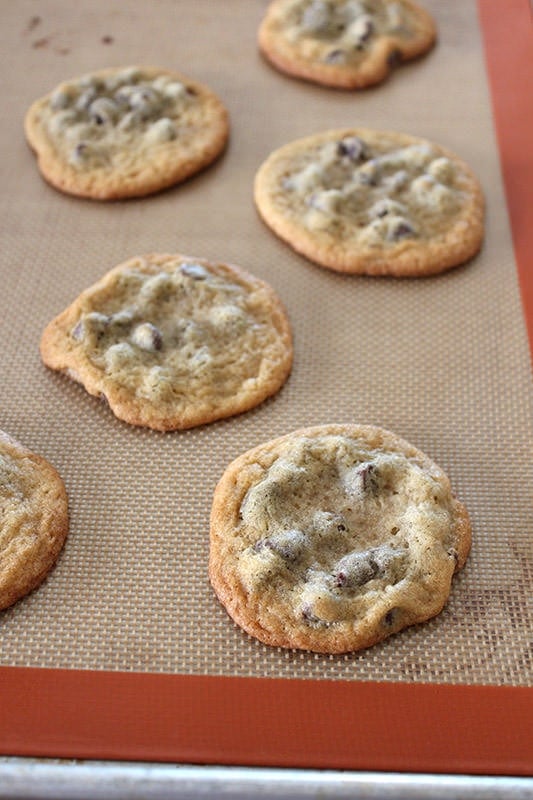
Silpat:
I received a few questions in my first Ultimate Guide to Chocolate Chip Cookies post about the effects of using parchment paper vs. a Silpat nonstick baking mat. Silpats are reusable non-stick baking mats often used in professional kitchens. I love my Silpats and have been baking with them for almost exclusively for so long that I never stopped to think how it might be affecting my baking products. I’ve heard some people claim their baked goods don’t become as browned and caramelized when using a Silpat, so I wanted to see if I experienced the same result in a side-by-side comparison with the control batch baked on standard parchment paper. The differences between the two batches were negligible, if anything the Silpat batch was slightly darker on the bottom and taller with a little less spread. I find these to be pleasant outcomes, so I will absolutely continue using my Silpat!
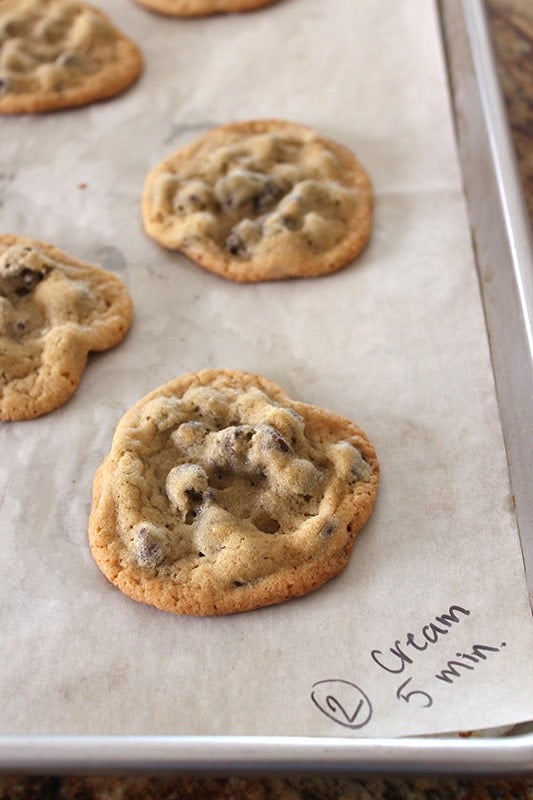
5 Minute Creaming:
This is something I think many people don’t pay attention to when baking cookies. In all my Ultimate Guide posts about chocolate chip cookies, my control recipe called for a specific 2 minutes of creaming. I counted those minutes exactly with a timer to ensure consistency and accuracy. I get a lot of questions from readers about cookies spreading too much in the oven. While many things can cause this, such as butter and/or dough that is too warm, overmixing butter can also lead to similar results.
The purpose of creaming the butter and sugar in a cookie recipe is to dissolve the sugar into the butter in a sense so the dough is homogeneous and bakes evenly. It also incorporates millions of tiny air bubbles into the batter, which in partnership with the leavener (baking soda in this case) helps to create a more airy, lifted texture. This is CRUCIAL when baking cake recipes which are intended to turn a dense batter into an ultra soft, tender, light, airy, and tall cake. Over-beating the butter in a cookie recipe, however, can cause the butter to warm too much and weaken its ability to hold air. Cookies just can’t become super tall and structured, so if the butter and sugar are over-beaten, they tend to spread and fall flat. I almost always call for 2 to 3 minutes of creaming time in an electric mixer on medium-high speed, this is usually enough time to homogenize the dough without risking over-beating. In this test batch, I creamed for exactly 5 minutes, an amount of time I felt might be easy for many home bakers to reach and over-cream without realizing. I wanted to see if this was enough creaming to negatively impact the cookies. The impact wasn’t huge, creaming longer would definitely exaggerate things. However, these cookies were certainly more pale, flat, soft, and light. They were also more misshapen, as though the butter was warm enough to melt out into whichever direction it wanted.
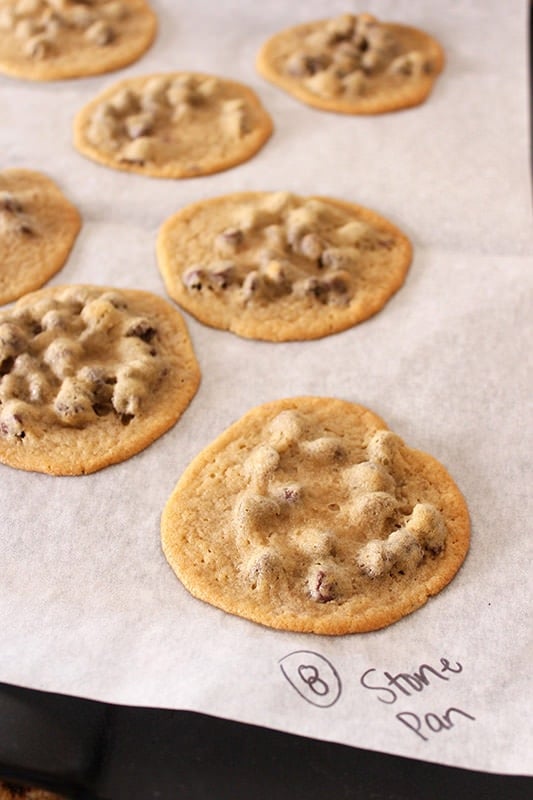
Stoneware:
I have received some comments from folks saying that they prefer to bake their cookies on stoneware. This made sense to me, as stoneware often heats more evenly than many metal baking sheets. I dropped the cookie dough onto parchment on my favorite Emile Henry baking stone which I use religiously for pizza. The stone was at room temperature and I placed it in a 350°F oven. I don’t know what happened, but whatever it was it was not good. The cookies turned into flat puddles with absolutely NO browning. They were completely under-baked, soft, and thin. They basically looked and tasted like melted cookie dough, not baked cookies. They were almost impossible to remove from the stone without having them fall apart. I was fairly shocked. I actually don’t think the tragedy behind these cookies is fully illustrated in the photos. If anything, I feared these cookies would be too brown. I don’t know if it was the dough recipe, the Tollhouse adaption is quite a wet dough, or if it was because I didn’t preheat the stone. Whatever it was I think I’ll avoid using stoneware for cookies altogether. They’re also more of a pain to lug out and to clean. I’d be curious to hear your thoughts on stoneware! Maybe I just used the wrong product or method. Either way, I thought the results might be useful or interesting to some of you.

375°F Baking Temperature
The original Nestle Tollhouse recipe is baked at 375°F. For all my Ultimate Guide experiments I switched the oven temperature to a more typical 350°F as my intention was to test out variations on the most average control cookie recipe. A few readers have pointed out this change in temperature, so I set out to test why the Tollhouse recipe would originally call for a higher baking temperature. I closely monitored my oven with an oven thermometer and once it reached 375°F I baked off a batch for exactly 10 minutes, like every other batch. A relatively small variance in temperature resulted in very different cookies. These chocolate chip cookies were much darker with a more crisp, crunchy texture. There was no ooey-gooey center whatsoever, however they did have a lovely depth of caramel-y flavor. I did enjoy these cookies, and I think I’ll bake off cookies at 375°F whenever I’m in the mood for that crisp texture.
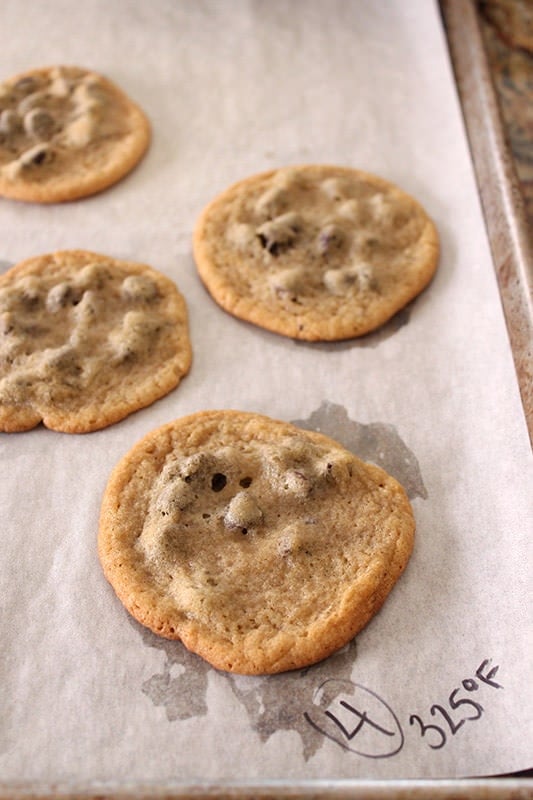
325°F Baking Temperature
On the flip side, I wanted to test out how dropping the oven temperature from 350°F to 325°F might affect the cookies. Dropping the temperature didn’t produce as different results as raising the temperature. These cookies were slightly softer with a chewy bite. The one thing they were noticeably lacking was that wonderful butterscotch, caramel-y flavor that chocolate chip cookies usually have. I don’t see why I’d use a lowered baking temperature again with chocolate chip cookies.
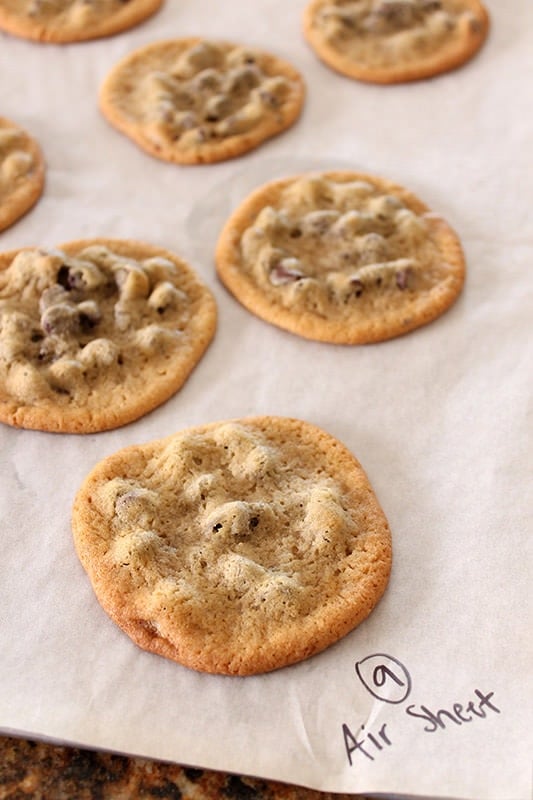
Air Baking Sheet
Another product that people seem to swear by are air baking sheets; baking sheets that are insulated and meant to prevent over-browning or burning. These cookies were flatter, perfectly round, with crisp edges. Unsurprisingly, the bottoms were not as brown as with the control recipe. I baked these for 10 minutes like I baked every other batch, but these cookies could have used another minute or two. I actually prefer more crisp, browned, caramelized cookies so I don’t think I’ll use insulated/Airbake sheets in the future.
Final Comparison:
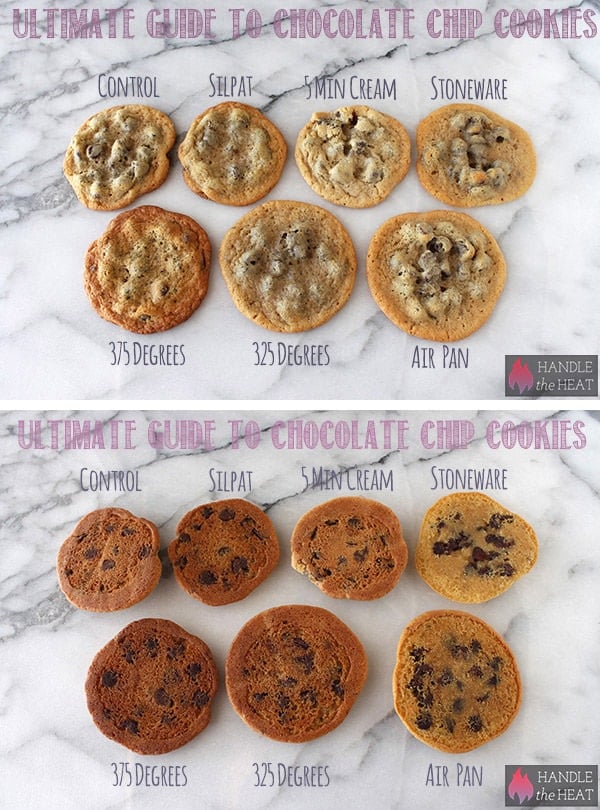
*If you use these images PLEASE give proper credit to me and link back to this post.*
All Four Guides in Comparison:
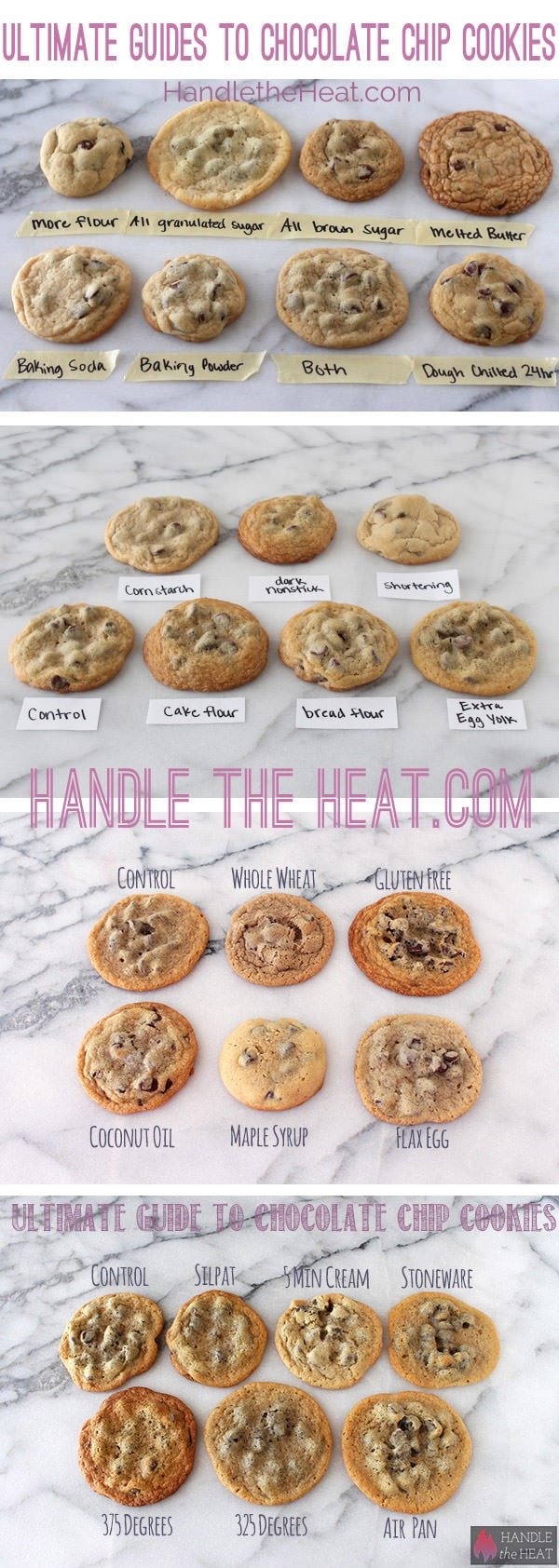

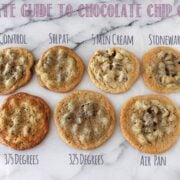

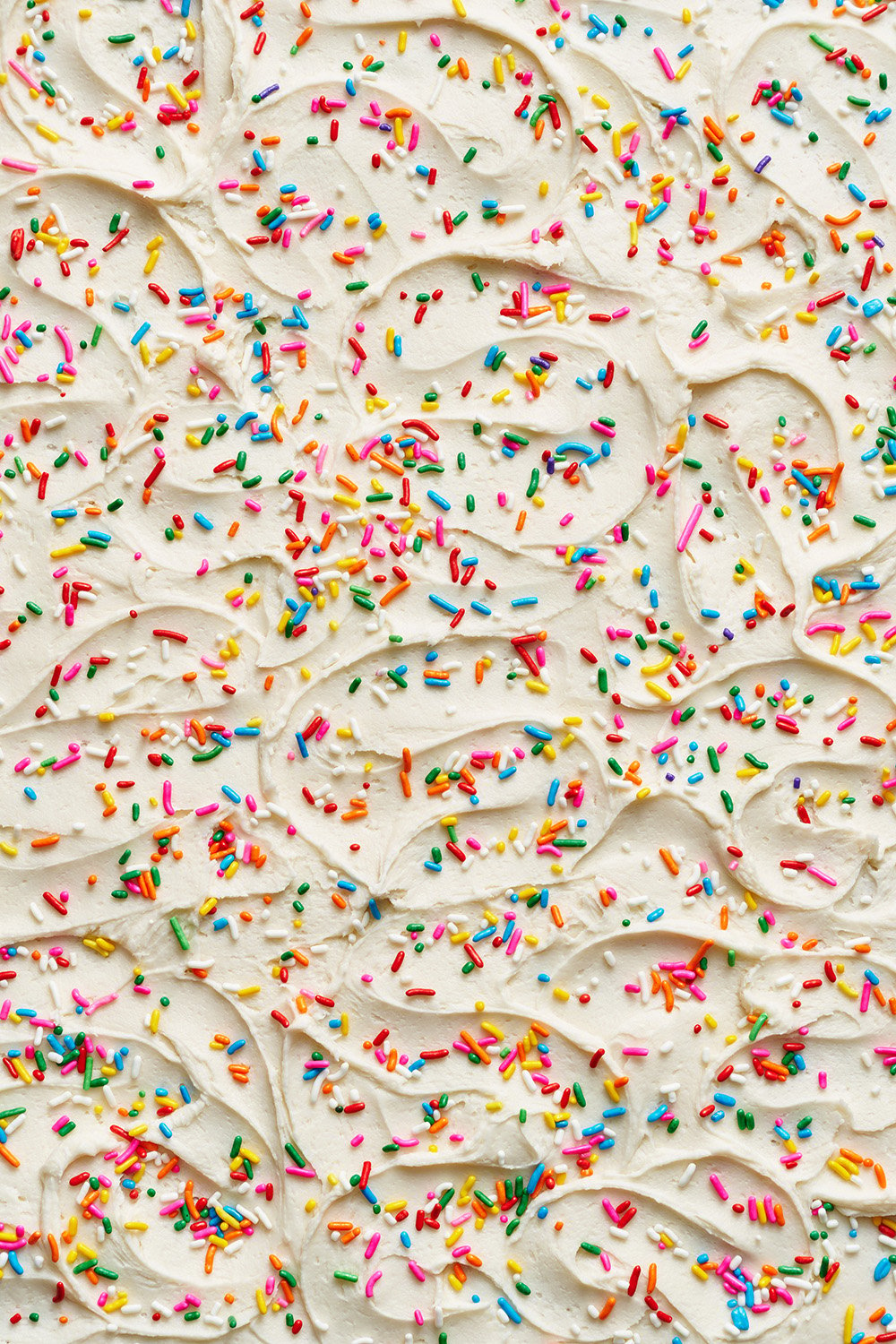
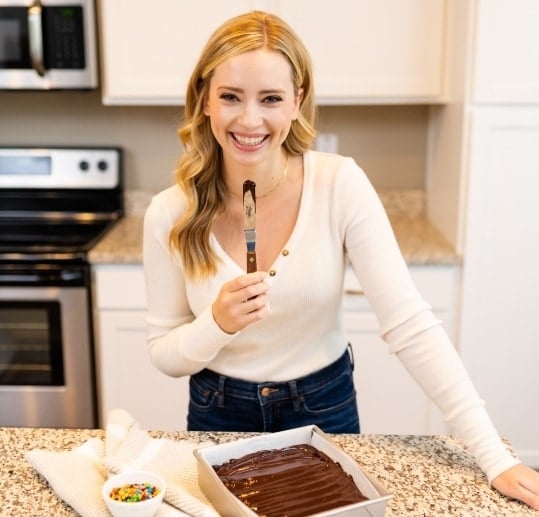


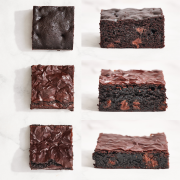
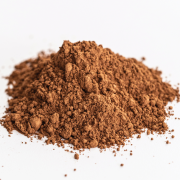
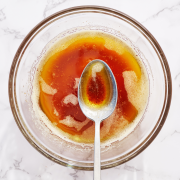

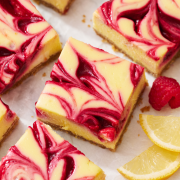

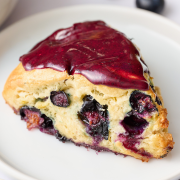








This may hae been said already (there are a lot of comments), but my pampered chef stone is meant to be preheated then you are to put the food on it. So you’d preheat your stone while the oven preheats then place your pizza or cookie dough (or whatever elso you’re cooking) on it. I know it makes a huge difference for me when I do pizzas as they turn out much crispier, so I would assume it would make cookies brown more too. Worth a try.
Also, although this has do to with another cookie post, have you attempted using Ener-G Egg Replacer? My cousin is highly allergic to eggs and her mother has always had me use it for any dishes requiring eggs brought to family events. It hasn’t not worked in a recipe yet!
Thanks for doing all these cookie experiments. Having a kiddo who has a milk allergy and now a boyfriend who is gluten intolerant, I’ve loved seeing how the outcomes of some of your experiments without having to mess up my kitchen!
Hello Tessa, I thoroughly enjoyed reading your research & all the work you did in putting together the “Ultimate Chocolate Chip Cookie Guide?” While looking for the best chocolate chip cookie recipe, I “stumbled” on your site. I’ve been pleased with what I’ve seen so far.
Really good job on the cookie tests, much appreciated!
I am wondering if you have more tests in the works? I would love to find a way to make a domed gooey chocolate chip cookie. Not exactly cakey. Not a brownie either. Have you ever seen or eaten one of these? I can’t figure out how to make one though. Would love to hear back if possible.
Hoping you have another test on the way, even if not with a domed, thick cookie in it. Just a great idea
Hi,
I was wondering if you ever use the bake convect option on the oven. I usually use this to bake. This option bakes at 325 and usually takes less time.
Thanks!
I’m curious if you have made chocolate chip cookies with all brown sugar and either baking soda or baking powder or both and refrigerated for 24 hours?
I’m curious why you call it an *adapted* version when it appears to be just halved (nestle toll house is my go-to recipe). By the way I loved reading all four parts to your ultimate cookie guide, I can’t wait to try a few of your variations next time I make chocolate chip cookies, the extra egg yolk in particular! I’ve also downloaded your cookie customization chart.
I adored these 4 “Ultimate Chocolate Chip Cookie” blog posts. I’m wondering how adding peanut butter to a chocolate chip cookie recipe affects the cookie and what needs to be adjusted to compensate? … you’re clearly a pro! Any tips?
Thanks!!
I use stoneware nearly every time I make chocolate chip cookies! I heat the stone and then open the oven and drop rounded cookie dough balls on the hot stone while it is still on the oven rack. The cookies are done in 7-8 minutes. I transfer them directly from the stone onto a cooling rack. They are perfect every time! I would not suggest parchment paper.
I’m trying to make thin, crispy chocolate chip cookies. I’ve made one batch of the “control” recipe and they were soft, and puffy, not crispy, more like the pictures of “more flour” cookies and/or “baking powder” cookies. Then I made your Thin and Crispy recipe with the same result. I thought that with baking soda and no baking powder the cookies would have spread more. The dough was not “loose, sticky and more like batter consistency” as you described. I made one significant change. I used white granulated baking Truvia rather than regular white, granulated sugar using a 1/1 ratio. The brown sugar I kept the same as in the recipe. Also, I used 1 tsp of vanilla rather than 2 because this is Hatian vanilla and has a much more intense flavor. Thank you for any guidance you can offer. Joanne
Hi Joanne, I would refrain from any sugar substitutions until you have a better sense of how the recipe should work. Then you can start experimenting with subs. Also, it sounds as though you may be adding in too much flour. This can be really easy to do accidentally if using measuring cups to measure out the flour. I would check out my measuring guide, specifically the section about flour, to see just what I mean: https://handletheheat.com/ultimate-guide-measuring/
So out of all four of the experiments which ones do you think turned out the best from each test not including the control.
Hi I am on a journey to design my perfect chocolate chip cookie recipe and your article has been so much help! I’ve been toying around with a recipe and changing variables and I’m happy to say I’m almost there! The one ingredient I’m not sure about you didn’t mention in your article. The first recipe I started with called for a few tablespoons of canola oil and now I always add it in but I’m curious to know what it brings to the mix. I’m on a mission to find the softest, cakiest cookies I can but with a bit of a chew right around the crust. I appreciate it a ton!
Hello,
I found your “Ultimate Guide to Chocolate Chip Cookies” really interesting. Your testing was done well. I have been doing this type of experimenting with chocolate chip cookies for years to try to get the perfect cookie and texture. I have been an avid baker for about 40 years now and I’m known in “my world” to have the best chocolate chip cookies. I found a recipe about 15 years ago in an old Betty Crocker cookbook that had the combination I was looking for. Thanks for the article; I’m sure it will be helpful for a lot of bakers.